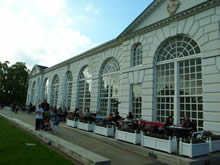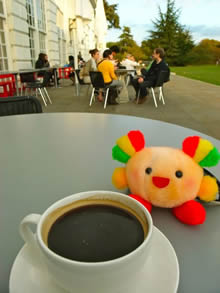
Chapter 37: ”Kew Gardens” in England
第37回はイギリス「キューガーデン」からお届け!
Hey everyone, it’s me, MaguMagu-chan!
ハロー! まぐまぐちゃんです。
I made it to the Royal Botanic Gardens, otherwise known as ”Kew Gardens,” southwest of London, England’s capital.
イギリスの首都ロンドン南西部にある、王立植物園「キューガーデン(Royal Botanic Gardens, Kew)」にきたよ!
Within its 120 hectares are 6 big greenhouses where over 40,000 species of plants are raised and over 7 million types of specimens are preserved.
120ヘクタールの広い敷地に6つの大きな温室があって、約4万種以上の植物が育てられ、700万種を超える標本が所蔵されているよ。

At the time of the British Empire, Kew Gardens was a hub for ”plant hunters” who would sail around the world and bring back plants for research and selective breeding.
キューガーデンは、大英帝国時代にプラントハンターが世界中を船で旅して、植物を持ち帰って、研究や品種改良をしていたという拠点。
Useful plants were transplanted to plantations that met their growth conditions for mass production. For example, Chinese-made tea was transplanted to Sri Lanka and the Darjeeling area of India, and natural rubber from the Amazon Basin was transplanted to the Malaysian peninsula.
有用な植物を育成条件の合致する植民地に移植してプランテーションでの大量生産を図り、中国産のお茶をインドのダージリン地方やスリランカへ移植したり、アマゾン川流域産の天然ゴムをマレー半島へ移植していたよ。
Now that vegetation on Earth is declining so rapidly, Kew Gardens has also assumed the role of species preservation. Celebrating its 250th anniversary in 2009, it is currently the world’s most famous botanical garden with over a million people visiting per year. In 2003 it was named a UNESCO World Heritage Site.
地球上の植物が急速に失われている現在、キューガーデンは種の保存という役割も担っている。2009年には創立250年を迎え、現在では世界で最も有名な植物園として、年間百万人を越える入場者があるよ。2003年にはユネスコ世界遺産にも登録されたまぐ~。
Anyway, Kew Gardens is HUGE! I’m tired of walking around so much so I’ll stop for tea at the self-service Orangery Restaurant that’s also on the premises.
とにかくキューガーデンはひろーーい!! 歩きまわって疲れたので、敷地の中にあるセルフサービスのレストラン「オランジェリー・レストラン(Orangery Restaurant)」でお茶するまぐ~。
The Orangery is just like its name, a place for storing up oranges for the winter. It was built by court architect William Chambers (1723-96) after being designed in the London Summerset House.
オランジェリーとは、その名の通りオレンジを冬越しさせるための施設。ロンドン市内のサマセット・ハウスを設計した、宮廷建築家ウィリアム・チェンバーズ(William Chambers, 1723-96)の作品だよ。
During the Age of Discovery, it was impossible to bring oranges from their country of origin (e.g., India) to Europe and cultivate them because they couldn’t be grown in the climate of the Northern Alps. Therefore, at that time oranges were a luxury item exclusively for the lords and nobles, and the Orangery was one of the kinds of buildings that would be part of a palace or mansion.
大航海時代に原産国のインドなどからヨーロッパに持ち込まれたオレンジは、アルプスの北の気候では栽培が不可能だった為、当時は貴族や領主に限られた贅沢品で、オランジェリーは宮殿や大邸宅を構成する建築物の一つとなっているよ。
リスニング用音声はこちら(PC用)

